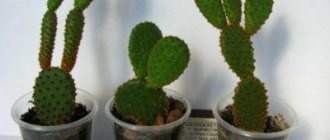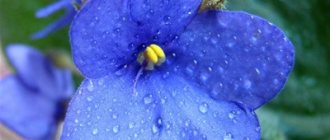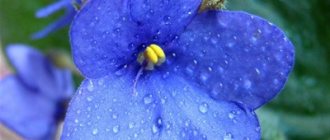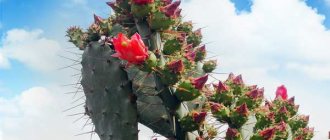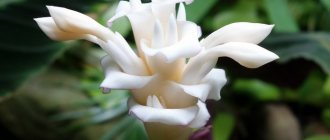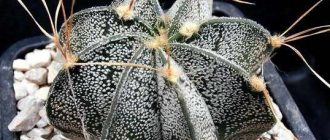Author: Elena N. https://floristics.info/ru/index.php?option=com_contact&view=contact&id=19 Category: Houseplants Published: February 21, 2019Last edits: October 18, 2021
- Care during flowering
- Cuttings
- Pests and their control
- White-haired prickly pear (Opuntia leucotricha)
- Beneficial features
plant (lat. Opuntia) belongs to the largest genus of the Cactus family, numbering about 190 species. In nature, prickly pears are common in North and South America, including the West Indies. Mexico is considered the main growing area for prickly pear, where about half of its species are concentrated. Aztec legend tells that Tenochtitlan, the main city of the Aztecs, was founded on the spot where an eagle sitting on a prickly pear ate a snake - this scene is depicted on the coat of arms of Mexico. The Indians used the fruits and shoots of some types of prickly pear for food, and also grew this cactus to produce the dye carmine. But among prickly pears there are neophytes that are so aggressive that it is necessary to use biological means of destruction against them. In indoor culture, prickly pear has taken root all over the world, right up to Australia.
Planting and caring for prickly pear
- Flowering: almost never blooms at home.
- Lighting: bright sunlight in the morning and diffused light in the afternoon.
- Temperature: in the warm season - normal for residential premises, in winter - no higher than 5-7 ˚C.
- Watering: in spring and summer - moderate, as for all succulents; in winter, if the cactus is at rest, do not water. To moisten the substrate, the method of bottom watering is used.
- Air humidity: does not matter.
- Feeding: once a month from March to September with complex mineral fertilizer with low nitrogen content. From October to March, fertilizing is not carried out.
- Dormant period: in the fall, watering is reduced, fertilizing is stopped, the cactus is placed at a temperature of 5-7 ˚C until spring.
- Transplantation: young plants are replanted annually, adults - no more than once every 3-4 years in the spring, before the start of active growth.
- Reproduction: by segments, rarely by seeds.
- Pests: spider mites, mealybugs, root nematodes, scale insects and whiteflies.
- Diseases: pythium root rot, late blight, gray rot and wet stinking rot.
Read more about growing prickly pear below.
How can I propagate
Prickly pear is easy to propagate. The easiest way is to plant a cutting. You can grow this cactus from seeds, but it is more difficult.
Reproduction by cuttings
- The best time for cuttings is late spring, early summer. The shoot (baby) is separated from the mother plant and left for a day to dry.
- The dried shoot is placed in damp sand or substrate (it must be pre-disinfected).
- The young plant is placed in a slightly shaded place for a week and is not watered.
- After a week, they begin to water abundantly, expose them to bright light, and provide fresh air.
- After the roots appear, the young prickly pear is transplanted into a permanent pot.
Botanical description
The prickly pear flower is a perennial evergreen cactus, which is an erect or creeping shrub or tree with succulent, jointed, flat stems with large or small spines and tufts of thin and fragile hook-shaped bristles called glochidia. The leaves of prickly pear are small, subulate and succulent. Prickly pear blooms with bisexual single flowers of yellow, orange or bright red. The fruits of the prickly pear cactus are edible berries with flat seeds in a hard shell.
Fruit
After flowering, fruits form in place of the buds located along the upper edge of the segments. Their color depends on the type of cactus. It can be anything: light green, pink, orange, red, purple. Prickly pear fruits are edible. Aborigines have been eating them for a long time. In America, the common name for the fruit is “Indian fig”. Their pulp is juicy, aromatic, and tastes like berries. There is a seed pod in the center of the fruit.
They ripen between September and November. In some plant species, the berries weigh up to 300 g. The yield of prickly pears is high. From 10 sq. m you can collect up to 200 kg of berries. The fruits are collected using long sticks with a rounded knife at the end. The thorns that come across during harvesting are swept away with brushes.
Caring for prickly pear at home
Growing conditions
The prickly pear cactus is light-loving, and it requires bright light all year round. However, prickly pear should be accustomed to direct sunlight gradually. Prickly pear feels good at home almost all year round, but in winter it is better to move it to a place where the temperature does not rise above 5-7 ºC, since wintering in a warm place causes the plant to stretch out strongly and painfully. Caring for prickly pear at home comes down to watering, fertilizing and replanting the plant.
Watering
In spring and summer, indoor prickly pear needs moderate watering, like all succulents, but in winter, if the plant is dormant and kept in a cool room, it does not need to be watered at all. The substrate in the pot should dry out between waterings.
- Sedum: growing from seeds, types and varieties
To moisten the soil, use the method of bottom watering, placing the pot with the plant in a container with soft, settled and slightly acidified water, for which several grains of citric acid are dissolved in one liter of water that has been standing for 24 hours. If you pour water under the root of a plant, as we do when watering other flowers, drops of water that fall on the stem of the prickly pear clog the pores, and this disrupts the breathing of the tissues, and cork growths form on the stems.
As for air humidity, under natural conditions prickly pear feels normal even in very dry conditions, so there is no need to spray the plant either in the summer heat or in winter, when heating devices work intensively.
Top dressing
Caring for prickly pear involves regular feeding during the period of active growth - complex mineral fertilizer with a low nitrogen content is applied to the soil once a month from March to September.
Transfer
Prickly pear does not like to be disturbed, so adult plants are replanted no more than once every 3-4 years, in the spring, before active growth begins, if there are no buds on the plant. Young prickly pears that have not reached three years of age are replanted annually.
Since the root system of prickly pear is weak, the pot for it should be shallow but wide. The substrate is made up of one part sand, two parts clay, two parts turf and four parts leaf soil and add a little expanded clay, crushed charcoal or broken brick, but in no case should humus be added to the soil mixture. Those who do not want to spend time preparing a substrate can use a store-bought cactus mixture.
The prickly pear is replanted together with an earthen lump using the transshipment method. After transplantation, the plant is not watered for a week.
Similar plants
- Prickly pear Sheri has the same round greenish segments as the fine-haired prickly pear. The flowers are pale yellow.
- White prickly pear blooms with large yellow flowers. The segments are densely strewn with setae and glochidia.
- Opuntia long-awned. The stem also consists of small green lobes covered with dense, short, thin needles.
- The Alba variety is a variety of small-haired prickly pear that grows as a compact bush. Short needles are densely planted over the entire surface of the plant.
- Sulfur-yellow prickly pear also has small lobes covered with thick light spines (read about how not to get pricked by a cactus and what to do if this happens). The plant is small, up to 40 cm in height.
Despite the fact that prickly pear is a desert flower, it requires careful and attentive treatment. Gentle light, moderate watering, careful feeding are necessary conditions for the growth and development of a flower.
Prickly pear blossom
Care during flowering
Prickly pear rarely blooms at home. It's hard to say what this is connected with. Either because it grows too slowly, or maybe because it is almost impossible to create for it the conditions in which it lives in nature. However, if you are lucky and buds form on your cactus, try not to spoil your holiday with an annoying mistake:
- do not rearrange or rotate the flower pot;
- do not replant the plant;
- do not change anything in care - both watering and fertilizing should be carried out strictly in accordance with the regime.
If you violate at least one of these rules, the plant may shed its buds, or they will degenerate into vegetative shoots, and a blooming prickly pear will remain your pipe dream.
Prickly pear after flowering
When the plant has flowered, its watering is gradually reduced, fertilizing is stopped completely, and then the cactus is transferred to an unheated room, where it will remain dormant at a temperature of 5-7 ºC without moistening or fertilizing until the beginning of the next growing season.
Interesting Facts
The Mexican Indians have a legend that the ancient Aztec state of Tenochtitlan was founded on the site where a large prickly pear shrub grew. At that time, the Aztecs did not have their own settlement and wandered through the mountains. One day they saw a cactus on which an eagle was sitting, having dealt with a large snake. This was interpreted by the leader as a good sign, and the Indians decided to found a city on this place. Now there is modern Mexico City (the capital of Mexico).
The Sicilian province annually hosts a festival dedicated to prickly pear. It is celebrated in October, when the harvest has already been harvested. The village is decorated with garlands and food tents are set up. The main treat is the berries of the plant, but there are many other goodies as well. You can taste a delicious liqueur made from prickly pear fruits, try different dishes from the queen of the holiday. At the end there is a fireworks display.
Popular signs say that prickly pear in the house protects against the evil eye and attacks from ill-wishers. If the plant is placed on a windowsill or table, then sorcerers will not be able to damage the owner. And according to modern concepts, cacti neutralize electromagnetic radiation emanating from a computer, TV, etc.
There is also a sign that prickly pear in the house is a sign of divorce. The plant with its energy attracts lovers and brings relationships to disintegration. In the Middle Ages, ladies used this ability to eliminate an annoying spouse. There is also an opinion that the cactus lives well in families where scandals and quarrels are frequent.
However, you should not blindly believe in prejudices. A passion for cacti indicates an unusual nature, a love for everything extraordinary. Blooming prickly pears are a wonderful interior decoration that creates a positive mood for all household members.
Prickly pear propagation
Cuttings
Prickly pear is propagated by cuttings and seeds, but it is easier to use the vegetative propagation method: segments are separated from the stem of an adult plant and dried in a vertical position for three to four days, until a dense film forms on the cut. Root the cuttings in disinfected damp sand, burying the stem segments 3 cm into it and covering the container with a plastic or glass cap. Ventilate the cuttings and moisten the substrate as needed.
Rooting occurs at a temperature of 20 ºC using bottom heating. When the cuttings grow roots, young prickly pears are planted in separate pots in the main substrate.
Prickly pear from seeds
Prickly pear seeds are covered with a very dense shell, so before sowing they need to be scarified, that is, treated with an abrasive - sandpaper or a file, so that the sprout can pass through the shell. After scarification, the seeds are kept in a pale pink solution of potassium permanganate for 10 minutes, and then sown in a sterile substrate consisting of crushed charcoal, river sand and leaf soil in a ratio of 1:2:2. Don’t forget to place a layer of expanded clay in the seed container under the substrate.
Germinate the seeds under a transparent cover at a temperature of 20 ºC, regularly ventilating the crops and moistening the substrate when it dries out. Seedlings are planted in separate pots and grown for two years in good light, but without direct sunlight, and then they are transplanted into soil for adult prickly pears.
- Photos of nertera species with species names
Where does it grow
Cacti form a family of perennial flowering plants. They were first discovered during expeditions to North and South America, and then brought to Europe. The species of opunts is the most common. In addition to Asian countries, Africa and Australia, Opuntia grows in the Mediterranean. In our country, the plant is found on the shores of the Black Sea, in Crimea. Prickly pear adapts well to different types of climate. It prefers semi-arid habitats. The cactus can grow on dirt, sandy, rocky soils. It only does not tolerate humid tropical climates and severe frosts. It is found on all continents except Antarctica.
Diseases and pests
Pests and their control
At home, prickly pear can be attacked by spider mites, mealybugs, nematodes, scale insects and whiteflies. Mites, whitefly larvae, scale insects and their close relatives mealybugs are sucking pests that feed on plant cell sap. They are destroyed by spraying the prickly pear with a solution of an acaricide - Actellik, Bankol, Decis or any other drug of similar effect. During processing, it is necessary to prevent the solution from entering the substrate. After 7-10 days the treatment should be repeated.
As for root nematodes, it is very difficult to detect their appearance, but if you look closely at the roots of prickly pear, you can see swellings on them that these root pests form. Using a sharp knife, these formations should be cut down to healthy tissue, after which the roots should be immersed in hot water at a temperature of 45-50 ºC for 10 minutes, but in such a way that the root collar remains dry. After the procedure, let the roots dry, treat the cuts with crushed charcoal and plant the prickly pear in fresh sterile soil.
Diseases and their treatment
Among the diseases, prickly pear can be affected by pythium root rot, late blight, gray rot and wet stinking rot. The cause of these diseases is fungi, which are activated under conditions of regular waterlogging of the soil and overfeeding of prickly pear with nitrogen fertilizer. Diseased areas must be removed, and the plant must be treated with a solution of a fungicide - Bordeaux mixture, Gamaira, Oksikhom, copper sulfate or other preparations of similar action. When spraying prickly pear with pesticides, follow safety precautions.
Microdasys Opuntia - cultivation requirements
Prickly pear needs the same conditions as most cacti. First of all, the plant does not like shade. It should be in a clear place where it will receive the greatest dose of sunlight. During the season, the ideal temperature for it is 21-35 degrees Celsius.
Prickly pear must be provided with a suitable substrate. It can grow in standard potting soil, but will still do much better in specialized cactus soil. A small layer of drainage should be placed at the bottom of the pots.
Types and varieties
It is impossible to describe all types of prickly pear cacti in one article, even those that are grown indoors, so we will briefly introduce you only to those that are more common than others.
White-haired prickly pear (Opuntia leucotricha)
It is a tree-like cactus with stems consisting of segments 10-20 cm long, which are densely strewn with bristles and yellow glochidia. This species blooms with golden flowers up to 8 cm in diameter with green stigmas. The fruits of the white-haired prickly pear are edible and have a pleasant aroma.
Berger's prickly pear (Opuntia bergeriana)
It is a perennial with bright light green segments 20-25 cm long and sparse areoles with yellow or yellow-brown spines of different sizes, as well as orange-yellow flowers with a green stigma that abundantly cover the plant.
Opuntia basilaris
Or the main prickly pear is a bush-like cactus with branching long stems, consisting of oval blue-green or reddish segments from 8 to 20 cm long. The areoles of this species are brownish, pubescent, depressed, with a small number of spines. Flowers of different shades - from pink to bright red. The species has varieties cordata and nana.
Gosselin's prickly pear (Opuntia gosseliniana)
It is also a bush-like cactus, which forms small clumps of thin segments of gray-green color in adult specimens and a reddish tint in young ones. The spines of this species are soft, growing mainly from the upper areoles. The flowers are yellow. This cactus has a variety called santa rita, the round segments of which are covered at the edges with a blue coating, and around the areoles a dark purple pattern can be discerned.
Opuntia longispina
Or prickly pear long-thorned is a bush-like creeping perennial with small, slightly flattened club-shaped spherical segments 3-4 cm long, which are formed in chains. The areoles of this species of prickly pear are brown, with red glochidia, red marginal spines and a long and thin central spine. The wide open flowers are orange or red.
Opuntia curassavica
It is a bushy perennial with hanging stems consisting of narrow, easily broken off light green segments from 2 to 5 cm long. The areoles are small, short-haired, with light spines.
Opuntia fragilis
It grows as a bush, its stems consist of easily falling round or almost flat segments 2-3 cm long. The areoles are small, spaced 8-12 mm from each other, with white pubescence, yellowish glochidia and four cross-shaped yellow-brown spines up to 3 in length cm. The flowers of this species are pale yellow with green stigmas.
Opuntia microdasys
It has a branched stem reaching a height of 50 cm and consisting of small rounded dark green segments. The white areoles contain many golden-colored glochidia. The flowers have a whitish style and a golden yellow interior.
Indian prickly pear (Opuntia ficus-indica)
Or ficus indica - a bush-shaped cactus with a lignified, erect, highly branched stem in the upper part, consisting of oval segments of gray-green color, covered with sparsely spaced areoles with easily falling yellowish glochidia and single white spines. The flowers of this species are bright red. The fruits are edible, reddish, green or yellow, pear-shaped, with white translucent sweetish pulp and large seeds.
Opuntia scheerii
A strongly branching cactus with segments from 15 to 30 cm long, greenish-blue. The densely located areoles bear yellow needle-shaped spines up to 1 cm long, brown glochidia and corymbose hairs. The pale yellow flowers with a green pistil become salmon pink as they wilt.
- Indoor plants after summer - what to do before returning to the house?
Opuntia compressa
It has creeping shoots with rounded bright green segments. The spines are either absent or located at the ends of the shoots. The leaves are rounded-pointed, the flowers are light yellow.
Recipes
Before starting cooking, the cladodes should be cleared of thorns and rinsed well. The berries must be peeled.
Omelette
This is a traditional Mexican dish. To prepare it you need prickly pear pulp, 2-3 chicken eggs, two tablespoons of flour, grated cheese, and spices. The prickly pear leaf must be cut so that it remains whole at the base, and the rest is strips 1 cm thick. The leaves are boiled for 20-25 minutes until soft. The eggs are broken into a cup, mixed with flour, and salted. The cactus pulp is dipped in batter and placed in a frying pan with heated olive oil. Fry on both sides, add spices. Before serving, sprinkle with grated cheese. You can eat the omelette with tomato or cream sauce.
Prickly pear salad
To prepare you will need: 2-3 prickly pear leaves, cucumber, celery stalk, canned peas. The cactus pulp is soaked in cold water for 15 minutes. Then the top layer of the peel is cut off. The leaves are cut into cubes with a side of 1 cm, brewed with boiling water for 10-15 minutes. This is necessary so that they soften and acquire a pleasant taste. Chop the cucumber and celery and place in a salad bowl. Pieces of prickly pear and peas are also added there. The salad is dressed with balsamic sauce. You can add a pinch of ground chili pepper.
Jelly
To make a beautiful jelly, you need to take prickly pear berries that are red, yellow or cherry in color. For half a kilogram of fruit, take 500 ml of water, two tablespoons of sugar, and a bag of gelatin. The berries are peeled and cut into slices. Place in a blender and blend until pureed. Gelatin is diluted with a small amount of warm water. Berry puree is poured into a pan of water and brought to a boil. Then cook over low heat for 10-15 minutes. The swollen gelatin is poured into the mixture and stirred. The mass is cooled, poured into molds, and set to freeze.
Properties of prickly pear
Beneficial features
All parts of prickly pear have beneficial properties. The fruits and leaves of the plant contain protein, glucose, calcium, phosphorus, magnesium, the stems contain starch, protein, sugar, ascorbic acid, and the flowers contain amino acids necessary for the human body. Prickly pear is rich in vitamins A, B1, B2, B3 and C. In addition, prickly pear is a source of soluble and insoluble fiber.
Preparations from prickly pear are used:
- for diabetes;
- for diseases of the respiratory system;
- for the treatment of diseases of the teeth and oral cavity;
- for hair and skin care;
- in case of disturbances in the nervous system;
- in case of metabolic disorders;
- for diseases of the musculoskeletal system;
- for problems of the cardiovascular system;
- for diseases of the digestive organs;
- to cleanse the body of waste and toxins;
- from a hangover;
- as a general tonic.
With the help of prickly pear, obesity, inflammation of the external integument, prostatitis, cystitis, rheumatism, diarrhea, various wounds and even measles are treated.
Prickly pear is used to produce oil, glue, pectin, food coloring, and is used to make deodorants and detergents.
Edible prickly pear oil, obtained by cold pressing the seeds or fruit, contains vitamin E, fatty acids and other beneficial substances that can slow down aging and skin sagging. Prickly pear oil is included in the most expensive face creams and is used for aromatherapy and for hair and scalp care.
Contraindications
Like any plant, prickly pear can cause individual intolerance in some people. Intolerance is determined by the appearance of headache, red spots on the body, nausea and vomiting within half an hour after taking the drug. If you experience these symptoms, you should stop taking prickly pear.
It is not recommended to use prickly pear and preparations made from it for those suffering from hemorrhoids and acute cystitis.
Since prickly pear is an exotic, unusual plant for us, in any case, before eating it or treating with drugs from it, you should consult a doctor.
Application
All parts of this plant are used in different fields. Flowers, cladodes, berries are used in:
- Cosmetology
- Cooking
- Agriculture
- Traditional medicine
Prickly pear flowers produce valuable oil that has anti-aging properties. It is used in the preparation of face and hair masks. It is also added to anti-aging creams. Vitamin E restores cellular structure, increases the turgor of the epidermis, nourishes and moisturizes it. This is an antioxidant that helps prolong skin youth.
Organic acids obtained from cactus pulp are used to make masks and creams for dull skin. Their use helps tighten problem areas of the face and neck and regenerates the cellular structure. Prickly pear fruit extract is added to tanning products and ointments for burns.
Cactus branches and leaves are fed to domestic animals. Thorns are removed by burning the collected parts of the plant. After heat treatment, the pulp becomes softer and more palatable. For feeding, fodder species of prickly pear are used, which are grown specifically for this purpose.
Prickly pear juice is used in folk medicine. Compresses are made from it to heal wounds and accelerate bone healing in case of fractures. These procedures also help with rheumatism and joint pain. Local residents use decoctions of dried fruits to treat vitaminosis and diseases associated with weakened immunity. Berry tincture helps against urinary tract diseases. Drinks from the flowers and roots of the plant improve the functioning of the prostate gland in men and prevent prostatitis.
Not only prickly pear berries are used in cooking, but also the pulp. Young shoots, the size of which is no more than 10 cm, are suitable for consumption. They are cut and eaten fresh or processed. Cladodes can be dried, pickled, stewed, baked. The Indians have long made various drinks using the pulp of cacti.
Prickly pear fruits have a more delicate and pleasant taste. They are eaten raw, and the following dishes are also prepared from them:
- sweet salads;
- jelly, marmalade;
- candies;
- preserves, jams;
- juice, wine, cocktails.
Transfer
The plant is replanted only when its roots fill the entire pot. The procedure is carried out in late spring. The succulent is transplanted into a larger pot than the previous one. The soil for growing the plant should be the same as for cacti, that is, poor and airy - based on peat and sand. Proper drainage and holes in the bottom of the container to drain excess water are important. When replanting, you can place broken pieces of ceramic pot, stones or coarse gravel at the bottom of the container.
When replanting plants, be careful with thorns, which can cause inflammation of the epidermis. All work should be done with gloves or the plant should be covered with hard paper.
